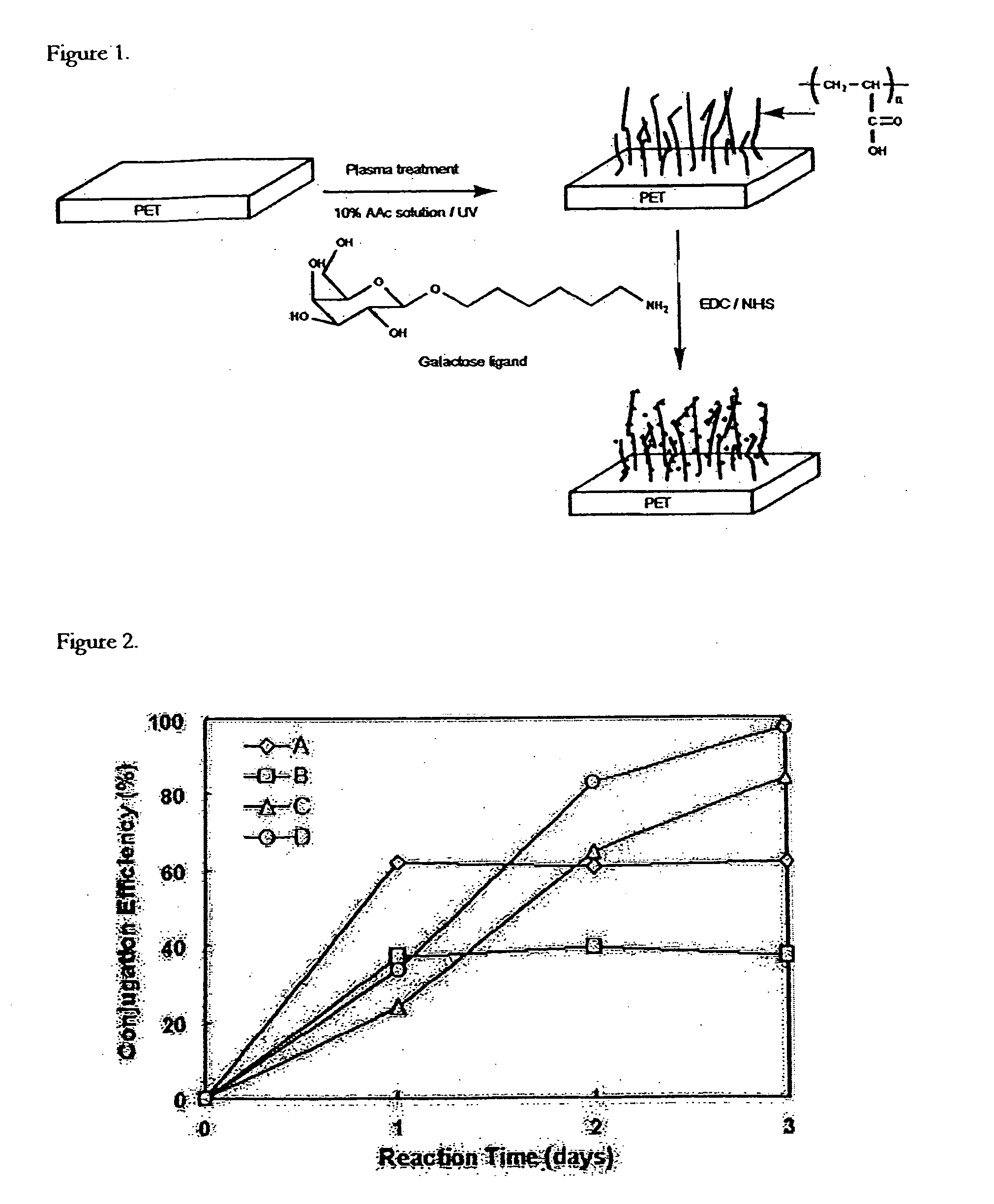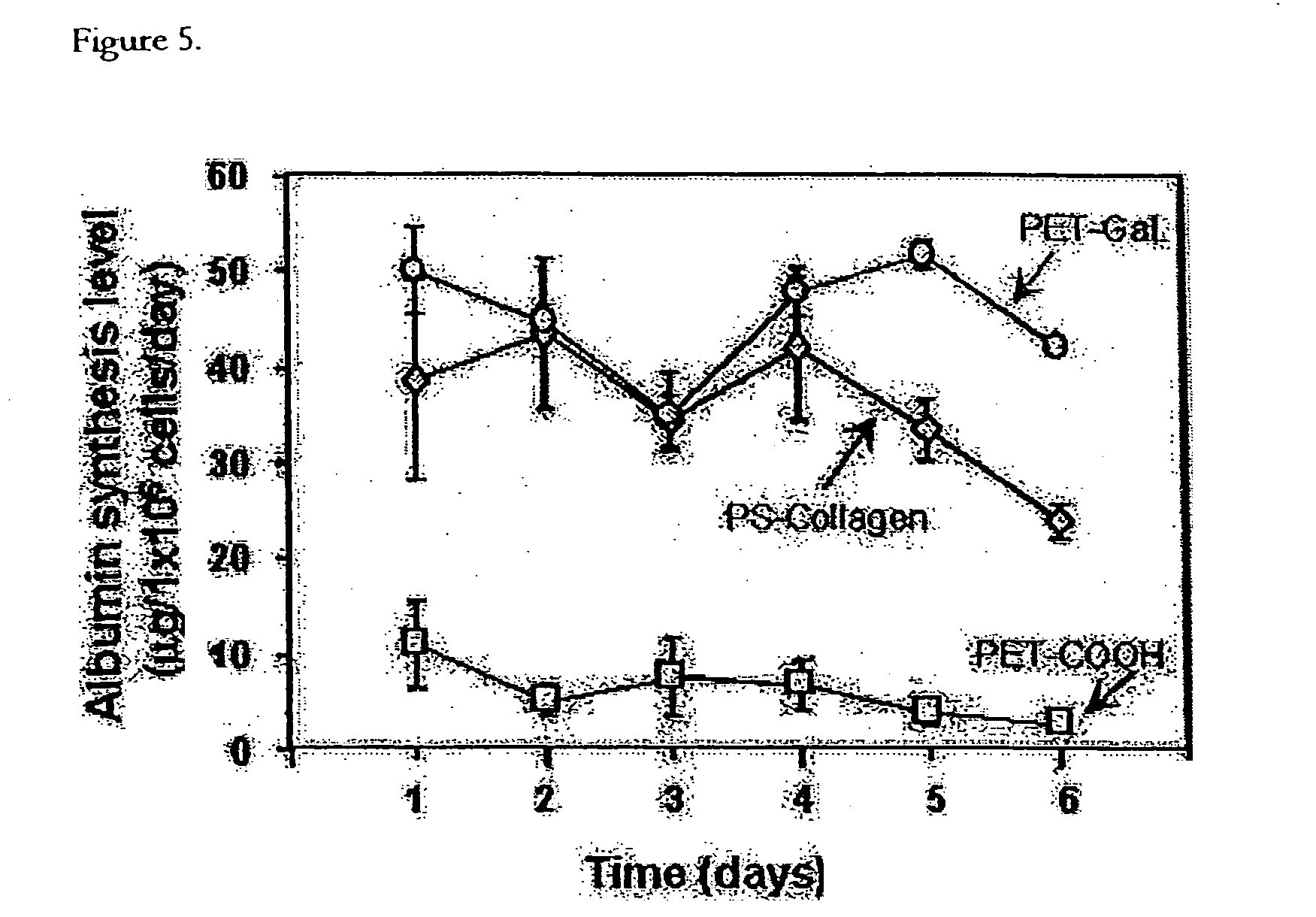Method of immobilization of clusters of ligands on polymer surface and use in cell engineering
a technology of polymer surface and ligand, which is applied in the field of polymer material functionalization, can solve the problems of large challenge in the application of such a hydrogel system into the bioreactor design, and achieve the effect of improving the biocompatibility of materials, high surface density of galactose ligands, and effective approaches to modify materials surface20
- Summary
- Abstract
- Description
- Claims
- Application Information
AI Technical Summary
Benefits of technology
Problems solved by technology
Method used
Image
Examples
example 1
Immobilization of High Density of Galactose Ligand on Polyethyleneterephthalate (PET) Membrane Surface (FIG. 1)
[0031] PET films with a thickness of 100 μm were purchased from Goodfellow (UK). Acrylic acid (AAc) and galactose was purchased from Merck (Germany). N-hydroxysuccinimide (Sulfo-NHS) was purchased from Pierce (USA). All other chemicals were purchased from Sigma-Aldrich unless otherwise stated.
[0032] PET Surface Grafting With Polyacrylic Acid (PAAc)
[0033] The PET film was cut into pieces with a dimension of 2.5 cm×5 cm, and cleaned with alcohol for 5 min in an ultrasonic water bath. These PET films were placed between the two parallel plate electrodes of a quartz cylindrical-type glow discharge cell (Model SP100, Anatech Ltd., USA) and subjected to the glow discharge for 30 sec under an argon pressure of 0.5 Torr. The plasma power and radio frequency were kept at 30 W and 40 kHz, respectively. The Ar plasma-treated PET films were then exposed to oxygen gas for 30 min, and...
example 2
Binding Affinity of Surface Conjugated Galactosyl Group to FITC-Lectin
[0045] Samples of PET films with surface area of 3 mm2 were incubated with 250 μL of FITC-lectin solution (from psophocarpus tetragonolobus, 250 μg / mL) for 1 h at 37° C. The samples were washed extensively with water, and observed under an Olympus FLUOVIEW confocal microscope (εex 488 nm). In a parallel experiment, free galactose was added to the FITC-lectin solution to yield a final concentration of 5 mg / mL before incubating with the modified PET film.
[0046] FITC-lectin was used to confirm the binding activity of the surface conjugated galactose ligands. The lectin used in this study was from psophocarpus tetragonolobus and could specifically bind galactose or N-acetyl-D-galactosamine. FITC labeled lectin was used in order to visualize the binding under confocal fluorescence microscope. Different PET films (unmodified, PAA-grafted and galactosylated) were incubated with FITC-lectin for one hour at 37° C. and wa...
example 3
Attachment and Morphology of Hepatocytes Cultured on Different Surfaces
[0048] Hepatocytes were harvested from male Wister rats weighting from 250 to 300 g by a two-step in situ collagenase perfusion as described previously29. NIH guidelines for the care and use of laboratory animals (NIH Publication # 85-23 Rev. 1985) have been observed. Hepatocyte viability was determined to be 90-95% using the Trypan Blue exclusion method.
[0049] Unmodified and modified PET films were cut into round discs with a diameter of 15 mm and fixed to the wells of a 24-well tissue culture plate with 5-10 μL of chloroform. The plate was sterilized by incubating with 70% ethanol for 3 h and washed with PBS for 3 times. Collagen-coated surface was used as a control and was prepared by placing 0.5 mL of collagen solution (0.5 mg / mL in PBS) in each well, leaving the plate overnight at 4° C. The solution in each well was aspirated and the wells were washed with PBS for 3 times.
[0050] Five types of surfaces wer...
PUM
| Property | Measurement | Unit |
|---|---|---|
| thickness | aaaaa | aaaaa |
| pressure | aaaaa | aaaaa |
| temperature | aaaaa | aaaaa |
Abstract
Description
Claims
Application Information
 Login to View More
Login to View More - R&D
- Intellectual Property
- Life Sciences
- Materials
- Tech Scout
- Unparalleled Data Quality
- Higher Quality Content
- 60% Fewer Hallucinations
Browse by: Latest US Patents, China's latest patents, Technical Efficacy Thesaurus, Application Domain, Technology Topic, Popular Technical Reports.
© 2025 PatSnap. All rights reserved.Legal|Privacy policy|Modern Slavery Act Transparency Statement|Sitemap|About US| Contact US: help@patsnap.com



